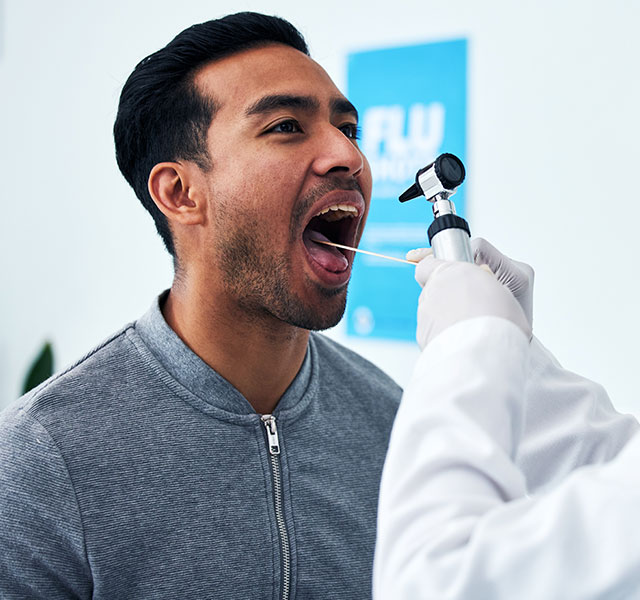More people are getting oral or oropharyngeal cancer, with nearly 60,000 cases of these mouth and throat cancers projected for 2024, according to the American Cancer Society. This is compared to 54,000 just a few years ago, rising at a rate of about 1% per year. And depending on the stage of cancer at diagnosis, the outcomes can be devastating.
“Oral and oropharyngeal cancers can affect your ability to eat and swallow. They can also restrict your speech,” says Samantha Tam, M.D., an otolaryngologist (ear, nose and throat specialist) at Henry Ford Health. “And depending on where the cancer is, there can also be dramatic changes to your physical appearance, especially if it presents at a later stage.”
What Are Oral And Oropharyngeal Cancers?
Oral or oropharyngeal cancers are any cancer in the mouth and throat, including the gums, lips, tongue, salivary glands, tonsils and middle of the throat. These cancers also fall under the umbrella of head and neck cancer.
While scientists aren’t completely clear why rates of oral cancer are climbing, one theory is that the spike reflects an increase in the rates of human papillomavirus (HPV). While there are more than 150 HPV viruses, only certain strains are linked to cancer.

ENT Care At Henry Ford
“With HPV vaccination in place, we're hoping to see oropharyngeal cancer rates decreasing over time,” Dr. Tam says. “In the meantime, cancer in the oropharynx cavity—the back of the tongue, tonsils, soft palate and sides and back of the throat—is more common than cervical cancer, with regard to HPV-linked cancers.”
What Are The Risk Factors For Oral And Oropharyngeal Cancers?
While oral and oropharyngeal cancers don’t seem to have a large inherited risk the way many other cancers do, they are associated with several key risk factors, including:
- Gender: Men have more than double the risk of developing oral cancers as women, in part because they’re more likely to engage in lifestyle behaviors that are linked with oral cancers.
- Age: Historically, oral cancers typically occurred in people over 55. But with rising HPV rates in recent years, oral cancers among people under 55 is becoming more common.
- Tobacco use: Smoking cigarettes and e-cigarettes increases the risk of all types of oral cancer. Chewing tobacco and dips are linked to cancer in the cheeks, gums and lips. And smoking tobacco through a pipe is associated with cancer in the lips, especially in areas where the pipe rests.
- Alcohol use: Heavy and frequent drinking increases the risk of cancer, including mouth and throat cancer. If you add smoking to frequent drinking, the risk of oral cancer is even steeper. Your best bet: Avoid smoking, and drink alcohol in moderation—one drink per day for women and two drinks per day for men.
- HPV: The HPV strain HPV16 is most closely associated with cancers in the mouth and throat. These HPV-related cancers have increased dramatically in recent years due to changes in sexual behaviors, including increased frequency of oral sex. To reduce your risk, practice safe sex and talk to your doctor about whether getting the HPV vaccination makes sense.
- Sun exposure: Time in the sun, especially unprotected, is a risk factor for cancer of the lips. Limit time outside during peak sunlight hours, (10 a.m. to 2 p.m.). And make broad-spectrum sunscreen and lip balm with a sun protection factor (SPF) of 30 or higher part of your daily routine.
What Are The Signs Of Oral Or Oropharyngeal Cancers?
Oral and oropharyngeal cancers often grow and spread without any pain or noticeable symptoms. Unfortunately, there are no screening exams for these cancers.
It’s important to be aware of your risk factors and monitor your lips, gums, cheeks, tongue and throat for suspicious lesions and changes. You should also plan to see your dentist regularly.
“The best way to ensure that your oral cavity and oropharynx is thoroughly checked is by getting regular dental exams,” Dr. Tam says. “Your dentist or hygienist will check for signs of cancer. If they see anything unusual, they’ll refer you to a specialist.”
Between dental visits, be sure to check your mouth and throat for:
- Bleeding, pain or numbness in your mouth
- Lumps in your neck
- Mouth pain or sores that don’t heal within two weeks
- Sensation that something is stuck in your throat
- Sore throat or hoarse voice that doesn’t go away
- Swelling in your jaw
- Trouble swallowing, chewing or speaking
- White or red patches or lumps anywhere in your mouth or throat (cheeks, gums, tongue and tonsils)
Early detection improves the outlook for oral cancer. “A small cancer in the mouth is usually easily treated with surgery alone, and those patients tend to do very well,” Dr. Tam says. “More advanced disease requires more extensive surgery, often along with radiation and chemotherapy, and has a less favorable prognosis.”
In every case, it’s important to pay attention to your teeth and gums and practice good oral hygiene. That way, you’ll not only be able to maintain a healthy balance of good bacteria in your mouth (which helps protect against cancer), but you’ll be better equipped to notice changes.
Reviewed by Samantha Tam, M.D., an otolaryngologist who sees patients at Henry Ford Cancer - Detroit and Henry Ford Medical Center - Fairlane.



